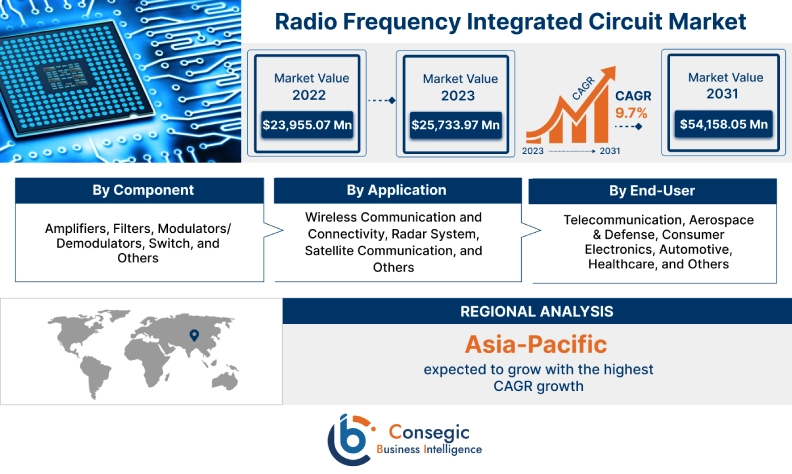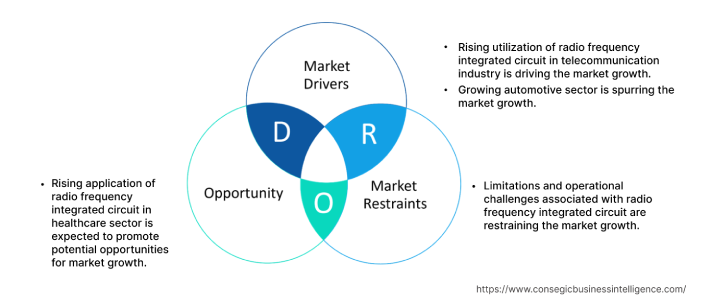- Summary
- Table Of Content
- Methodology
Radio Frequency Integrated Circuit Market Size :
Global Radio Frequency Integrated Circuit Market Size is estimated to reach over USD 54,158.05 Million by 2031 from a value of USD 23,955.07 Million in 2022 and is projected to grow by USD 25,733.97 Million in 2023, growing at a CAGR of 9.7% from 2023 to 2031.
Radio Frequency Integrated Circuit Market Scope & Overview :
A radio frequency integrated circuit (RFIC) refers to electronic circuit that is designed to handle radio frequency signals. They are optimized for operating at high frequencies, usually in the range of several hundred MHz to several GHz. Moreover, they offer a range of benefits including high data transfer rates, wide coverage, efficient signal processing, low noise, high gain, and others. Their aforementioned benefits are major determinants for increasing its deployment in telecommunication, aerospace & defense, consumer electronics, automotive, healthcare, and other industries.
Radio Frequency Integrated Circuit Market Insights :
Key Drivers :
Rising utilization in telecommunication industry.
Radio frequency integrated circuits are primarily used in the telecommunication sector, particularly for communication and transmission of data over the wireless medium as electromagnetic waves. Their ability to support various frequency bands including 4G, 5G, and others make it ideal for deployment in communication base stations and network stations.
Analysis of market trends concludes that factors including the growing deployments of 5G infrastructure, rising adoption of smartphones and advanced communication devices, and increasing demand for wireless communication are major prospects driving the expansion of the telecommunication sector.
For instance, according to the Ookla 5G Map, the total deployment of 5G network reached 112 countries in November 2021, representing an incline of 13% as compared to 99 countries in November 2020. Furthermore, Telefonica deployed its 5G services to nearly 1,400 municipalities in Spain in 2022, with the target of reaching 2,400 municipalities by the end of 2023, demonstrating an incline of 71.4%.
Therefore, the of development of telecommunication industry is fostering the utilization of RFICs for its application in telecom base stations and network stations for communication and transmission of data over the wireless medium, in turn driving the radio frequency integrated circuit market demand.
Growing automotive sector.
Radio frequency integrated circuits are used in automotive sector, specifically in automotive radar systems for applications including adaptive cruise control, collision avoidance, and parking assistance among others. Moreover, their compact form factor enables its easy mounting in vehicles to provide improved safety.
Analysis of market trends concludes that factors including rising automotive production, increasing investments in automobile manufacturing facilities, advancement in autonomous driving, and growing adoption of electric vehicles are among the vital aspects driving the expansion of the automotive sector.
For instance, according to the International Organization of Motor Vehicle Manufacturers, the production of passenger cars across the world reached 61.59 million in 2022, representing an increase of around 8% as compared to 57.05 million in 2021.
Meanwhile, according to the European Automobile Manufacturers Association, the production of passenger cars in European Union reached up to 10.9 million in 2022, demonstrating an incline of 8.3% in contrast to 2021. Hence, the rise in automobile production is driving their adoption for application in automobile radar system, in turn boosting the radio frequency integrated circuit market demand.
Key Restraints :
Limitations and operational challenges associated with radio frequency integrated circuit.
The utilization of circuits is usually associated with few limitations and operational challenges, which is a key factor limiting market proliferation.
For instance, RFICs mostly require medium to high power, which makes it inappropriate for battery powered applications or devices. Moreover, they are often associated with high design complexities, particularly for deployment in small devices.
Additionally, they require mandatory compliance with regulatory standards including Federal Communications Commission (FFC) regulations, Radio and Telecommunications Terminal Equipment Directive (R&TTE), Australian/New Zealand Standard (AS/NZS 4268:2003), and others. Therefore, the aforementioned limitations and operational challenges associated with them are constraining the expansion of the market.
Future Opportunities :
Rising application in healthcare sector.
The rising application of circuits in healthcare sector is expected to present potential opportunities for the development of the radio frequency integrated circuits market. They are often used in healthcare sector, particularly in medical devices such as MRI machines, pacemakers, wireless patient monitoring devices, and others. Moreover, their characteristics including compact form factor, ultra-low power operation, higher accuracy, enhanced efficiency, and others are primary determinants for increasing its utilization in medical devices.
Analysis of market trends suggest that factors including the ongoing rise in healthcare expenditure, rising incidence of chronic diseases, and growing investments in efficient medical imaging solutions for early detection of diseases are primary aspects driving the expansion of the healthcare sector.
According to American Medical Association, the total healthcare spending in the United States reached up to USD 4.3 trillion in 2021, depicting an incline of 2.7% as compared to 2020. Moreover, healthcare expenditure in the U.S. accounted for 18.3% of the total GDP in 2021. Additionally, the European Commission invested approximately USD 6 billion budget during the 2021-27 period for facilitating the healthcare sector in Europe.
Hence, rising investments in healthcare sector are projected to increase the integration of circuits for application in medical devices, in turn is emerging as one of many radio frequency integrated circuit market opportunities that drive market expansion during the forecast period.
Radio Frequency Integrated Circuit Market Report Insights :
| Report Attributes | Report Details |
| Study Timeline | 2017-2031 |
| Market Size in 2031 | USD 54,158.05 Million |
| CAGR (2023-2031) | 9.7% |
| Based on the Component | Amplifiers, Filters, Modulators/Demodulators, Switch, and Others |
| Based on the Application | Wireless Communication and Connectivity, Radar System, Satellite Communication, and Others |
| Based on the End-User | Telecommunication, Aerospace & Defense, Consumer Electronics, Automotive, Healthcare, and Others |
| Based on the Region | North America, Europe, Asia-Pacific, Latin America, and Middle East & Africa |
| Key Players | Qorvo Inc., NXP Semiconductors, Qualcomm Technologies Inc., Broadcom, Infineon Technologies AG, Microchip Technology Inc., Renesas Electronics Corporation, STMicroelectronics, Silicon Laboratories, Texas Instruments Incorporated |
Radio Frequency Integrated Circuit Market Segmental Analysis :
By Component :
Based on the component, the market is bifurcated into amplifiers, filters, modulators/demodulators, switch, and others. The amplifiers segment accounted for the largest revenue share of 31.74% in the year 2022. Amplifiers refer to devices that are designed for amplifying the weak signals or output of the mixer to a higher power for transmission. Moreover, the utilization of amplifiers offers a range of benefits including enhanced signal quality, increased coverage, and improved reception among others. Assessment of market trends suggest that the aforementioned benefits of amplifiers are driving its utilization in telecommunication, aerospace & defense, consumer electronics, healthcare, and other industries.
For instance, in October 2023, CommScope launched its new STARLINE RF amplifier integrated with modular designs with electronic setup including equalization, attenuation, and node segmentation. Therefore, the rising innovation associated with RF amplifiers is among the primary factors driving the radio frequency integrated circuit market growth.
The filter segment is anticipated to register the fastest CAGR growth during the forecast period. RF filters are designed for restricting the signals in a specific frequency band. Moreover, RF filters offer several benefits including protection of circuits from power spikes and surges, filtering of unwanted harmonics, and reduction in electromagnetic interference among others. Additionally, RF filters are primarily used in consumer electronics, automotive, telecommunication, and other industrial sectors.
For instance, in September 2023, Akoustis Technologies Inc. launched its new XBAW RF filter that features ultra-wide bandwidth and high performance for mobile and wireless communication applications. The RF filter solution offers increased power handling, significant form factor reduction, and improved rejection performance. Therefore, rising advancements related to RF filters for deployment in industrial applications are anticipated to boost the proliferation of the market share during the forecast period.
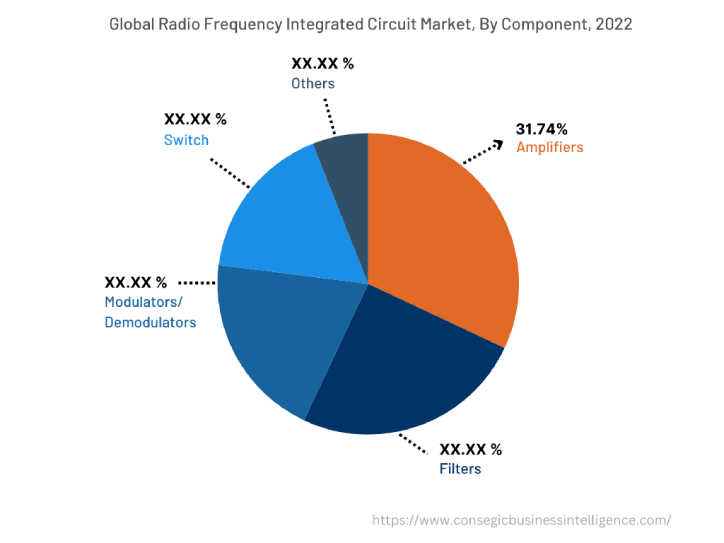
By Application :
Based on the application, the market is segregated into wireless communication and connectivity, radar system, satellite communication, and others. In 2022, the wireless communication and connectivity segment accounted for the highest radio frequency integrated circuit market share. The circuits are primarily used for wireless communication in mobile phones, Internet of Things (IoT) devices, and others. They enable transmission and retrieval of voice and data signals across multiple frequency bands and standards including 4G LTE and 5G, which makes it ideal for application in wireless communication systems. Additionally, Bluetooth and Wi-Fi-enabled devices rely on these circuits for connecting to networks and communicating with other devices, which enables seamless data sharing and internet access.
For instance, Silvers Semiconductor AB offers TRB02801 and TRB03901 models of RFICs in its product portfolio that are specifically designed for wireless communication applications among others. The circuits are capable of supporting full frequency range from 24.25 to 43.5 GHz with speeds up to 5 Gbit/s. Examination of market trends conclude that the increasing development of these circuits for use in wireless communication application is a prime factor proliferating the radio frequency integrated circuit market growth.
The radar system segment is anticipated to register fastest CAGR growth during the forecast period. The circuits are used in automotive radar systems for applications including adaptive cruise control, collision avoidance, and parking assistance among others. Similarly, they are also used in aviation & defense radar systems employed for detecting and tracking objects, analyzing weather patterns, and other related applications.
For instance, in April 2023, Cadence Design Systems Inc. partnered with TSMC to optimize complete 79GHz mmWave design reference flow on the N16 process for developing highly reliable, optimized, next-generation of circuit designs for utilization in radar applications automotive and aerospace industries among others. The radio frequency integrated circuit market analysis concluded that, the rising research and development activities related to circuits for radar applications is a significant factor projected to drive the expansion of the market during the forecast period.
By End-User :
Based on the end-user, the market is segregated into telecommunication, aerospace & defense, consumer electronics, automotive, healthcare, and others. In 2022, the telecommunication segment accounted for the highest radio frequency integrated circuit market share. Factors including the growing deployments of 5G infrastructure, rising adoption of smartphones and advanced communication devices, and increasing demand for wireless communication are driving the expansion of the telecommunication segment.
For instance, according to the Department of Telecommunication of India, the overall deployment of 5G base stations reached up to 324,192 units across India as of August 2023, witnessing a significant rise of over 100% from 53,590 base stations in January 2023 due to increasing demand of 5G services from general public. Assessment of market trends suggest that the development of telecommunication sector is driving the adoption of the circuit for utilization in base stations and network stations for communication and transmission of data over the wireless medium, in turn proliferating the expansion of the market.
Automotive segment is expected to witness the fastest CAGR growth during the forecast period. The development of automotive segment is primarily driven by multiple factors including rising automotive production, increasing investments in automobile manufacturing facilities, advancement in autonomous driving, and growing adoption of electric vehicles among others.
For instance, according to the China Association of Automobile Manufacturers, the overall manufacturing of passenger cars in China reached 14.8 million units in January-August 2022, demonstrating a YoY growth of 14.7%. The circuits are used in automotive radar systems for applications including adaptive cruise control, collision avoidance, and parking assistance among others. The radio frequency integrated circuit market analysis concluded that the growing automotive industry is projected to drive the market expansion during the forecast period.
By Region :
The regional segment includes North America, Europe, Asia Pacific, Middle East and Africa, and Latin America.
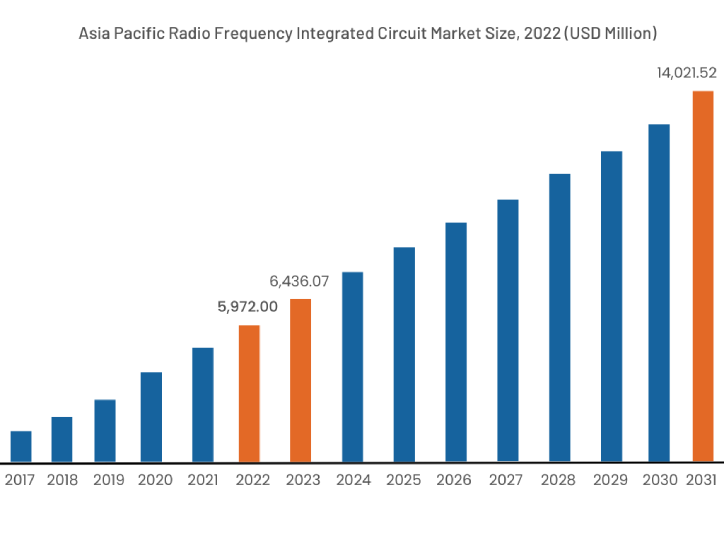
North America is estimated to reach over USD 18,527.47 Million by 2031 from a value of USD 8,135.14 Million in 2022 and is projected to grow by USD 8,744.62 Million in 2023.
The market growth for radio frequency integrated circuit in the North American region is mainly driven by its deployment in automotive, telecommunication, aerospace & defense, healthcare, and other industries. Analysis of radio frequency integrated circuit market trends concludes that the rising utilization of radio frequency integrated circuits in telecommunication infrastructure including base stations and network stations for communication and transmission of data over the wireless medium as electromagnetic waves are among the significant factors driving the market expansion in the region.
For instance, according to the GSM Association, the total 5G connection deployments across North America reached nearly 140 million as of 2022. Thus, the growing telecommunication sector is fostering the deployment of RFICsICC in base stations and network stations, attributing to its ability to support various frequency bands including 4G, 5G, and others, in turn driving market expansion in the North American region. Further, factor including the increasing investment in aviation & defense and healthcare sectors is anticipated to stimulate opportunities for market proliferation in North America during the forecast period.
Asia-Pacific is expected to grow with the highest CAGR growth of 10.2% and is estimated to reach over USD 14,021.52 Million by 2031 from a value of USD 5,972.00 Million in 2022 and is projected to grow by USD 6,436.07 Million in 2023. In addition, in the region, the China accounted for the maximum revenue share of 33.50% in the same year.
The growing pace of industrialization and development is providing lucrative development prospects for the market in the region. Analysis of radio frequency integrated circuit market trends concludes that the factors including the development of various industries including consumer electronics, aerospace & defense, telecommunication, and others are driving the market expansion for radio frequency integrated circuits in the Asia-Pacific region.
For instance, according to Invest India, the Government of India allocated USD 70.6 billion to the Ministry of Defense as the part of its Union Budget 2022-23. The primary focus of the budget allocation to the Indian Ministry of Defense is to help in the development of new unmanned aerial vehicles and systems, military ground vehicles, and other related systems. Hence, the rising investment in aerospace & defense sector is anticipated to drive the utilization of radio frequency integrated circuits for application in wireless communication system and military radar system, thereby, driving market expansion in the Asia-Pacific region during the forecast period.
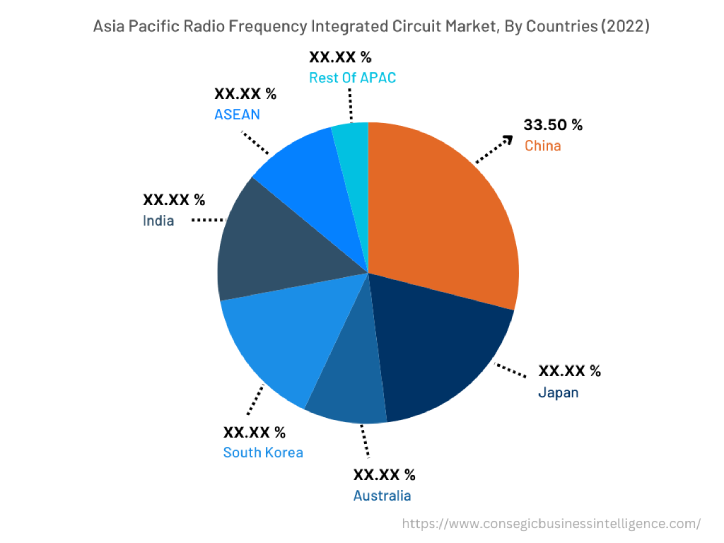
Top Key Players & Market Share Insights :
The radio frequency integrated circuit market is highly competitive with major players providing products to the national and international markets. Companies operating in the radio frequency integrated circuit industry are adopting several strategies in research and development (R&D), product innovation, and end-user launches to hold a strong position in the market. Key players in RFIC market include-
- Qorvo Inc.
- NXP Semiconductors
- STMicroelectronics
- Silicon Laboratories
- Texas Instruments Incorporated
- Qualcomm Technologies Inc.
- Broadcom
- Infineon Technologies AG
- Microchip Technology Inc.
- Renesas Electronics Corporation
Recent Industry Developments :
- In October 2021, Qualcomm Technologies Inc. introduced its new ultraBAW RF filter technology that is optimized for frequency bands ranging up to 7 GHz for facilitating high-performance 5G and wireless connectivity systems.
Key Questions Answered in the Report
What is radio frequency integrated circuit? +
A radio frequency integrated circuit refers to electronic circuit that is designed to handle radio frequency signals.
What specific segmentation details are covered in the radio frequency integrated circuit report, and how is the dominating segment impacting the market growth? +
For instance, by component segment has witnessed amplifiers as the dominating segment in the year 2022, owing to the increasing adoption of RF amplifiers in telecommunication, aerospace & defense, consumer electronics, healthcare, and other industries.
What specific segmentation details are covered in the radio frequency integrated circuit market report, and how is the fastest segment anticipated to impact the market growth? +
For instance, by end-user segment has witnessed automotive as the fastest-growing segment during the forecast period due to rising adoption of radio frequency integrated circuit in automotive radar system among others.
Which region/country is anticipated to witness the highest CAGR during the forecast period, 2023-2031? +
Asia-Pacific is anticipated to register fastest CAGR growth during the forecast period due to rapid pace of industrialization and growth of multiple industries such as consumer electronics, aerospace & defense, telecommunication, and others.
